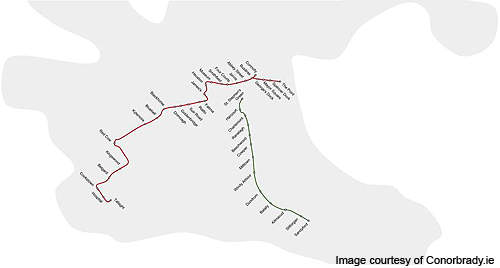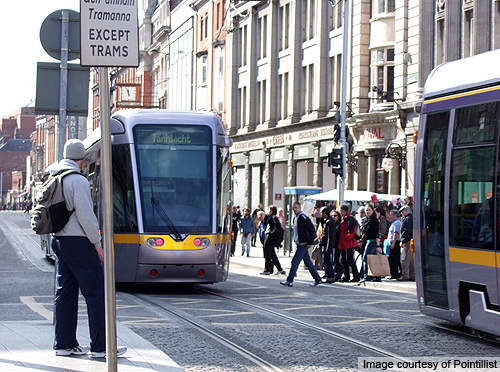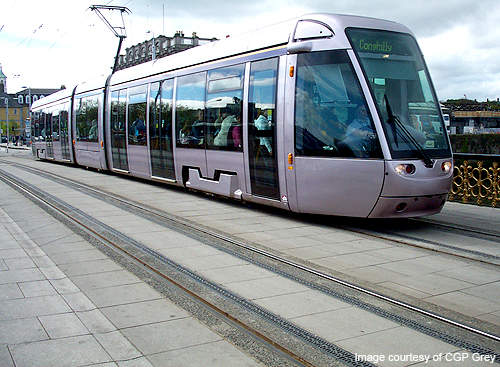The Luas Red Line is a tramway running between Connolly and Tallaght in Dublin County of Ireland. It opened in 2004 and since then has undergone two extensions under two different projects known as line C1 and line A1.
Line C1 is the first extension in which the existing Red Line was further extended to the east side of Connolly to The Point station in Docklands.
The 1.5km long extension opened in December 2009 and involved an estimated investment of €90m. This project is also known as Luas Docklands.
The second extension known as the Citywest extension or line A1 is a 4.2km long spur line from Belgard terminus to Saggart station. It was opened to the public in July 2011 and required an investment of about €150m.
Post to the two extensions, the Red Line measures 20.7km with 30 stations. It is owned by the Railway Procurement Agency (RPA) and operated and maintained by Veolia Transport on contract basis with RPA.
Lines and routes of the Luas Red Line
Line C1 starts from Busáras and runs on the east side of Connolly towards the docklands. It stops at Goerge’s Dock, Mayor Square / NCI, Spencer Dock and terminates at The Point station.
Line A1 is a spur line with five stations located at Fettercairn, Cheeverstown, Citywest Campus, Fortunestown and Saggart.
It diverges from the existing Red Line and runs through the Greenfield area in the traffic zone of Fettercairn and crosses the outer ring road near Brookfield.
From there, the line continues to run separately from traffic towards the Citywest Business Campus to cross the Citywest Road / N82 and Foutunestown and Garter Lane junction to terminate at Saggart.
Project details
The Red Line was extended as part of the Government’s transport 21 investment programme, which aims to expand Ireland’s road transport system through bus and rail networks.
Lines C1 and A1 were developed in five stages. Public consultation, route design, selection of stops, obtaining the permission to build and operate, and commencement of line operations were executed in phases one through five respectively.
The public consultation for line C1 was initiated in January 2001 and the route was designed in November 2003. Permission for the extension was obtained in February 2007 with construction commencing immediately.
Public consultation for line A1 was carried out in 2006. The spur line was originally planned between Belgard and to west of Fortunestown Lane in Tallaght.
Following discussions with South Dublin County Council and the local property developers, RPA decided to extend the proposed Citywest to Saggart section.
Permission to build and operate the Citywest extension was obtained in June 2008 following the receipt of railway order from An Bord Pleanála and construction of the line commenced in early 2009. Electrical systems were installed and the trams were tested for about two months starting in April 2011.
Line A1 or the Citywest extension is executed by a public private partnership between RPA, South Dublin Country Council and the private consortium of land owners and builders known as Citywest Luas (CLL). It is the first project to be approved by An Bord Pleanála, an independent body that foresees major infrastructure projects in Ireland.
Infrastructure of Dublin’s Red Line network
All the platforms are of uniform length of 40m. The width, however, varies at some stations to 3.3m or 4.1m.
Platforms on the initial Red Line and line C1 are built at a height of 280mm above track level with 5m access ramps on ether side. Platforms on line A1 are built straight with a provision to be extended to 90m in future.
The stations and trams are equipped with CCTV cameras and a public address system which are monitored and controlled from the central control room.
The Belgard station of line A1 serves as an interchange for the Red Line and Citywest extension. It has two track alignments. The new second track allows for the arrival and departure of trams. It also serves as a stabling track for the trams that run on Citywest extension.
Park and ride facilities with 312 bays are available at the Cheeverstown station of line A1. Other park and ride facilities on the Red Line are available at Red Cow and the Tallaght terminus.
Trams operate at headway of 6.5 minutes and eight minutes from The Point station to Tallaght during peak and non-peak hours respectively.
Trams on line A1 operate at headway of ten minutes and are expected to allow for an extra two million passenger journeys a year.
The net travel time from Saggart to Connolly is approximately 50 minutes and that between Tallaght and The Point station is 53 minutes.
Rolling stock
Two out of every three trams of the Red Line run directly from Tallaght to The Point station of line C1 and one out of three trams operate on line A1. As of 2007, about 26 trains were running on the original Red Line.
Following the opening of line C1, the tram length was extended from 30m to 40m to accommodate extra passengers. Four more trams were ordered in 2008, of which two were dedicated to line C1.
The new trams are manufactured by Alstom with an option to increase the fleet to serve the additional capacity of line A1.
The trams run on 750V DC power and are equipped with modern regenerative braking systems which save energy each time the tram brakes. The saved energy is fed back into the overhead electric cables to be used by other trams travelling on the same line.
Contractors
Many contractors were involved in the construction of line C1.
Mott MacDonald Pettit and RPA were the project lead designers. Main structures were designed by Arup. Future Systems and Arup jointly provided the structural design for the Spencer Dock Bridge.
Preliminary and civil works were carried out by SIAC Construction between June 2007 and September 2008. Installation of tram rails and ducting on the George’s Bridge was done by Sisk between May and September 2007.
The contract to construct a new bridge and an underground substation at the Spenser Dock Development was awarded to Liang O’ Rourke. Track rails were laid between April 2008 and December 2009. This work was carried by a joint venture of Liang O’ Rourke and Volker Rail, known as Mpact.
The design and supply of the points and crossings at the delta junction between Connolly, Busara and George’s Dock was delivered by VAE.
The signalling and communication infrastructure was designed and constructed by Somague Sacyr Bowen and their subcontractors Efacec.
Line A1 was proposed and constructed by CLL on behalf of RPA. Civil and track works were carried out by BAM Contractors. CLL contributed about 55% of the total project cost. The Department of Transport, Tourism and Sport also partly funded the line A1.






